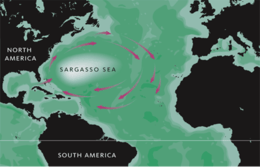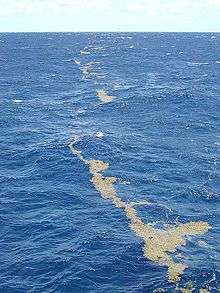Sargasso Sea


The Sargasso Sea is a region in the gyre in the middle of the North Atlantic Ocean. It is the only sea on Earth which has no coastline.[1] A distinctive body of water with brown Sargassum seaweed and calm blue water, it is very different from the rest of the Atlantic Ocean.[2]
The sea is bounded on the west by the Gulf Stream; on the north, by the North Atlantic Current; on the east, by the Canary Current; and on the south, by the North Atlantic Equatorial Current. It is 1,107 km wide and 3,200 km long (700 statute miles wide and 2,000 statute miles long). It stretches from roughly 70 degrees west to 40 degrees west, and from 20 degrees north to 35 degrees north. Bermuda is near the western fringes of the sea. This system of ocean currents forms the North Atlantic Gyre.
All the currents deposit the marine plants and refuse they carry into this sea, yet the ocean water in the Sargasso Sea is distinctive for its deep blue color and exceptional clarity, with underwater visibility of up to 61 m (200 ft).[3]
History
The naming of the Sargasso Sea after the Sargassum seaweed traces back to the early 15th-century Portuguese explorations of the Azores Islands and of the large "volta do mar" (the North Atlantic gyre), around and west of the archipelago, where the seaweed was often present.[4] However, the sea may have been known to earlier mariners, as a poem by the late 4th-century author Rufus Festus Avienus describes a portion of the Atlantic as being covered with seaweed, citing a now-lost account by the 5th-century BC Carthaginian Himilco the Navigator.
Ecology

The Sargasso Sea is home to seaweed of the genus Sargassum, which floats en masse on the surface there. The sargassum is not a threat to shipping, and historic incidents of sailing ships being trapped there are due to the often calm winds of the horse latitudes.[5]

The Sargasso Sea also plays a major role in the migration of both the European eel and the American eel. The larvae of both species hatch there and go to Europe or the East Coast of North America. Later in life, they try to return to the Sargasso Sea to lay eggs. It is also believed that after hatching, young Loggerhead sea turtles use currents, such as the Gulf Stream to travel to the Sargasso Sea, where they use the Sargassum as cover from predators until they are mature.[6][7]
In the early 2000s the Sargasso Sea was sampled as part of the Global Ocean Sampling survey, to evaluate its diversity of microbial life through metagenomics. Contrary to previous theories, results indicated the area has a wide variety of prokaryotic life.[8]
Pollution
Owing to surface currents, the Sargasso accumulates a high concentration of non-biodegradable plastic waste.[9] The area contains the huge North Atlantic Garbage Patch.
Several nations and nongovernmental organizations have joined together to protect the Sargasso Sea.[10] These organizations include the Sargasso Sea Commission[11] established on 11 March 2014 by the governments of the Azores (Portugal), Bermuda (United Kingdom), Monaco, United Kingdom and the United States.
Bacteria have been found in the plastic-polluted waters of the Sargasso sea that consume plastic; however, it is unknown whether these bacteria ultimately clean up poisons or simply spread them elsewhere in the marine microbial ecosystem. Plastic debris can absorb toxic chemicals from ocean pollution, potentially poisoning anything that eats it.[12]
Depictions in popular culture
The Sargasso Sea is often portrayed in literature and the media as an area of mystery.[13] In the 1910 publication Psmith in the City by P. G. Wodehouse, it has been used in a negative sense. To Mike, the bedroom he had to hire as a bedsit "seemed the most dismal spot he had ever struck. A sort of Sargasso Sea among bedrooms." The sea is referenced in the novel Wide Sargasso Sea.
- In the third episode of the third season of the Starz Network show, Black Sails, the crew of the pirate ship captained by Captain Flint finds itself stranded in the Sargasso Sea following an escape, from pursuing forces, into a storm tempest.
- In the music video for Modest Mouse's song "Dashboard", the musicians tell a fictional tale of when they visited the Sargasso Sea.
Stories set within the Sea
In 1846 Edward Forbes hypothesized a post-Miocene land mass extending westward from Europe into the Atlantic:
If this land existed it did not extend to America (for the fossils of the Miocene of America are representative & not identical): where then was the edge or coastline of it, Atlantic-wards? Look at the form & constancy of the great fucus-bank & consider that it is a Sargassum bank.[14]
The Sargasso Sea features in classic fantasy stories by William Hope Hodgson, such as his novel The Boats of the "Glen Carrig" (1907), Victor Appleton's Don Sturdy novel Don Sturdy in the Port of Lost Ships: Or, Adrift in the Sargasso Sea, and several related short stories. Jules Verne's Twenty Thousand Leagues Under the Sea describes the Sargasso Sea and gives an account of its formation.[15]
Other stories include:
- The 1923 silent film The Isle of Lost Ships, an atmospheric adventure from director Maurice Tourneur, takes place in the Sargasso Sea. The film was based on Crittenden Marriott's 1909 novel The Isle of Dead Ships. The Isle of Lost Ships is now a lost film. It was refilmed at the dawn of sound in 1929 by director Irvin Willat.
- Fred Andrew's mystery novel Plato's Pond[16] features the fictitious land of Gaia, which is a continent in the middle of the Sargasso Sea.
In several fictional depictions, the Sargasso Sea is detailed as a mythical floating ship graveyard in which ships get caught in the seaweeds and never get free again, turning the vessels into ghost ships. Versions of such are shown in:
- The German role-playing game book Schiff der Rätsel ("Ship of Mysteries"), by Uwe Anton.[17]
- The premier episode of Jonny Quest, "The Mystery of the Lizard Men" (Sept. 18, 1964), was set in the Sargasso Sea.
- The 1968 Hammer movie The Lost Continent is set almost entirely in the Sargasso Sea, depicted as a seaweed-choked region of the Atlantic; over centuries, so many ships have been trapped that a culture of the stranded and their descendants has come into being.
- In Carl Barks' Donald Duck #72, "The Secret of the Sargasso Sea", Donald, his nephews and Uncle Scrooge McDuck travel on an adventure to the Sargasso Sea.[18]
- In Kenneth Robeson's pulp series featuring Doc Savage, book #8 (#18 in publisher's order) is named "The Sargasso Ogre", with the story based in and around the Sargasso Sea.
- In the television show Futurama, the 'Sargaseous Sea' is a gas cloud known for terrible storms and space-shipwrecks.
References
- ↑ Administration, US Department of Commerce, National Oceanic and Atmospheric. "What is the Sargasso Sea?". oceanservice.noaa.gov. Retrieved 2015-10-19.
- ↑ Stow, 2004. p. 90
- ↑ "Sargasso Sea". World Book. 15. Field Enterprises. 1958.
- ↑ "The Sargasso Sea". BBC - Homepage. BBC. Retrieved 6 June 2011.
- ↑ "Sargasso". Straight Dope.
- ↑ "Turtles return home after UK stay". BBC News. 2008-06-30. Retrieved 2010-05-23.
- ↑ "Satellites track turtle 'lost years'". BBC News. 2014-03-05. Retrieved 2014-03-05.
- ↑ "Environmental genome shotgun sequencing of the Sargasso Sea.".
- ↑ "The trash vortex". Greenpeace. Retrieved 2008-04-20.
- ↑ Shaw, David (2014-05-27). "Protecting the Sargasso Sea". Science & Diplomacy. 3 (2).
- ↑ http://www.sargassoalliance.org
- ↑ Gwyneth Dickey Zaikab (March 2011). "Marine microbes digest plastic". Nature.
- ↑ Heller, Ruth (2000). A Sea Within a Sea: Secrets of the Sargasso. Price Stern Sloan. ISBN 978-0-448-42417-0.
- ↑ Forbes' letter to Darwin
- ↑ Verne, Jules (1870). 20,000 Leagues Under the Seas. Translated by Butcher, William (2001 ed.). Oxford University Press. ISBN 0-19-282839-8.
- ↑ Andrews, Fred. "Kemper Conseil Publishing". Kemperconseil.nl. Retrieved 2012-01-04.
- ↑ Anton, Uwe: Schiff der Rätsel. Ullstein Abenteuer Spiele. ISBN 3-548-21090-2.
- ↑
External links
| Look up Sargasso Sea in Wiktionary, the free dictionary. |
 "Sargasso Sea". Encyclopædia Britannica. 24 (11th ed.). 1911.
"Sargasso Sea". Encyclopædia Britannica. 24 (11th ed.). 1911.- Sargasso Sea Alliance
- "Skeptoid #132: The Sargasso Sea and the Pacific Refuse Patch". Skeptoid.
- What's the story on the Sargasso Sea? (The Straight Dope)
- Photos of organisms living in the Sargasso Sea
Coordinates: 28°N 66°W / 28°N 66°W